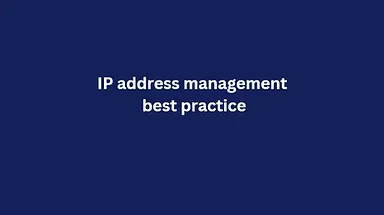IP address management (IPAM) is a critical component of network administration that ensures the efficient allocation, tracking, and utilisation of IP addresses within a company. Best practices in IP address management must be followed in order to maintain a stable and secure network infrastructure. Here are some key strategies and guidelines for best practices in IP address management.
Centralised IP Address Management
Create a centralised system or tool for allocating and tracking IP addresses. Using specialised IPAM software aids in the maintenance of a comprehensive inventory of IP addresses, allowing administrators to manage and monitor address assignments across the network more efficiently.Regular IP Address Audits: Conduct periodic audits to validate the accuracy of IP address assignments and identify discrepancies or unused IP addresses. This practice helps in reclaiming unused addresses, preventing IP address conflicts, and ensuring optimal resource utilization.
Structured Addressing Scheme
Create and implement a well-structured IP addressing scheme that meets the needs of the organisation. Using hierarchical addressing (such as subnetting and supernetting) can improve scalability and simplify management while lowering the risk of address exhaustion.
IP Address Documentation: Keep detailed records of IP address assignments, including device types, locations, owners, and allocation dates. Updating documentation simplifies troubleshooting, improves network visibility, and aids in the planning of future expansions or modifications.
IP Address Reservation and Pooling
To ensure the availability of critical devices or services such as servers, routers, and printers, reserve specific IP addresses. Create IP address pools for dynamic assignment (DHCP) to efficiently assign addresses to devices while avoiding conflicts.
Automated IP Address Management: Use automation to streamline the allocation and management of IP addresses. Automated IP address provisioning and deprovisioning reduces human error, improves efficiency, and enables the rapid deployment of new devices or services.
Security Measures
Put in place security measures to protect IP addresses from unauthorised access or misuse. This includes limiting IPAM system access, implementing strong authentication mechanisms, and encrypting sensitive IP address data.
IP Address Version Transition: As IPv6 adoption grows, support both addressing schemes to ensure readiness for the transition from IPv4 to IPv6. Plan for the coexistence of IPv4 and IPv6 networks to allow for a smooth transition without disrupting services.
Backups and Redundancy: Back up IP address management databases on a regular basis to avoid data loss and ensure quick recovery in the event of a system failure. Redundancy should be implemented in IPAM systems to ensure continuous availability and minimise downtime.
Training and documentation
Train network administrators and staff on best practices for IP address management, emphasising the importance of following established procedures. Comprehensive documentation and guidelines aid in the maintenance of consistency and the transfer of knowledge within the team.
Implementing these best practices in IP address management contributes significantly to a network infrastructure’s stability, security, and scalability. Organisations can effectively mitigate potential issues, optimise resource utilisation, and adapt to evolving networking requirements by establishing efficient allocation, tracking, and documentation processes.




Wow! This could be one particular of the most useful blogs We have ever arrive across on this subject. Basically Excellent. I am also a specialist in this topic therefore I can understand your effort.